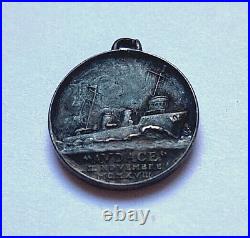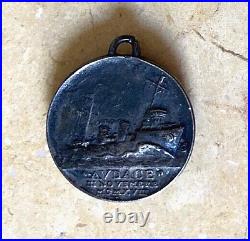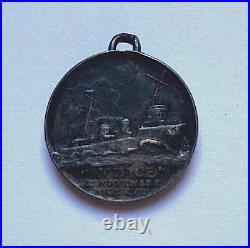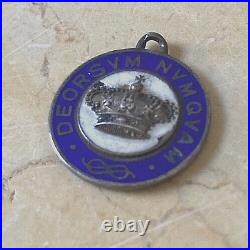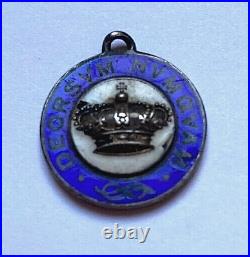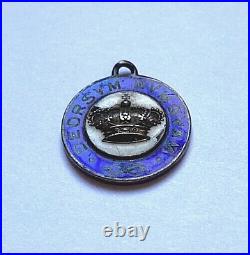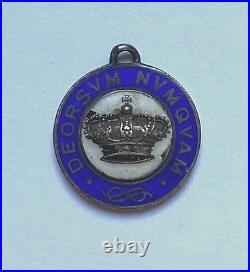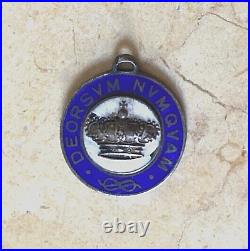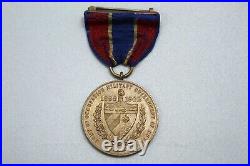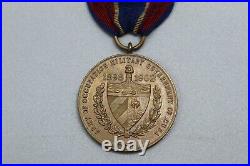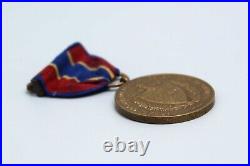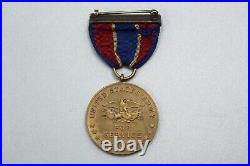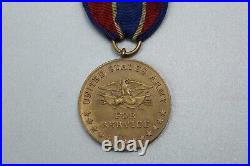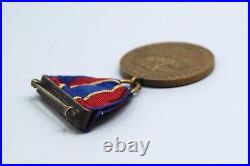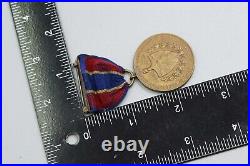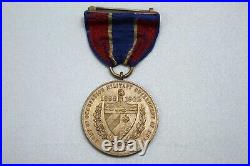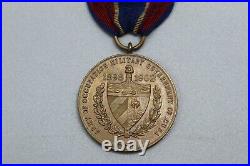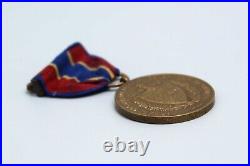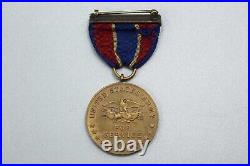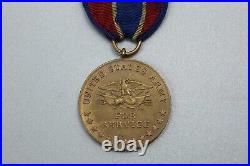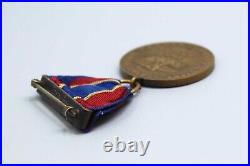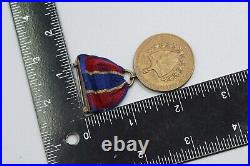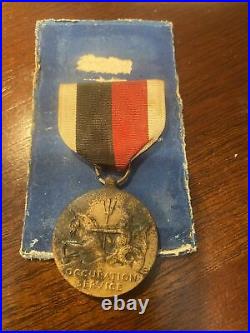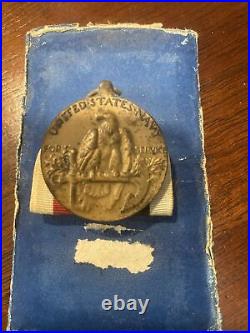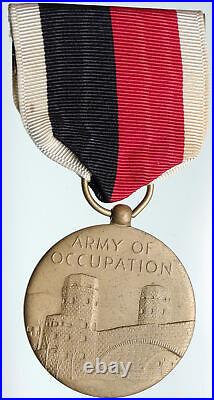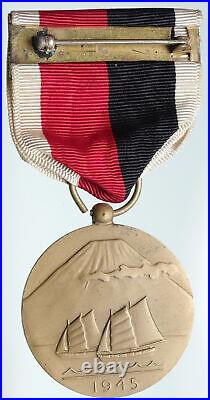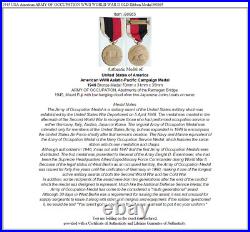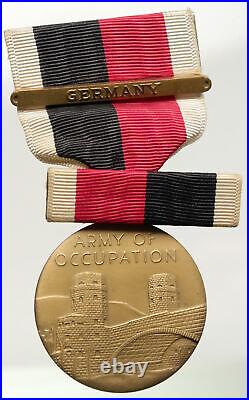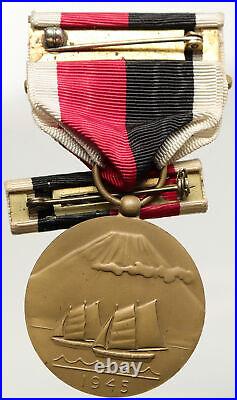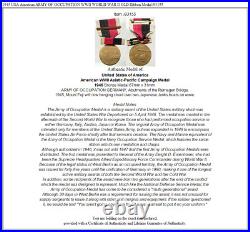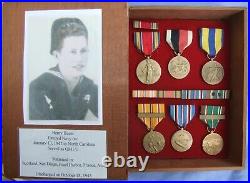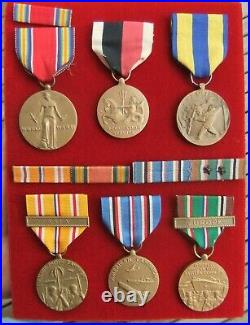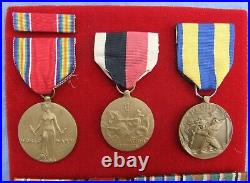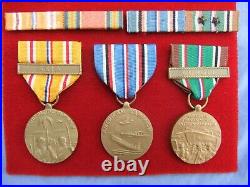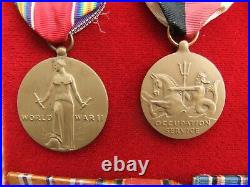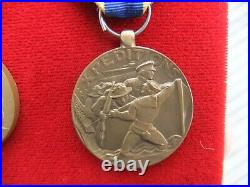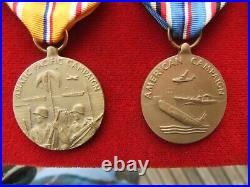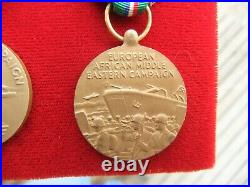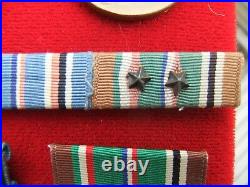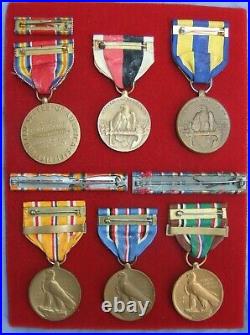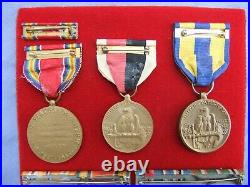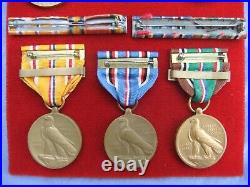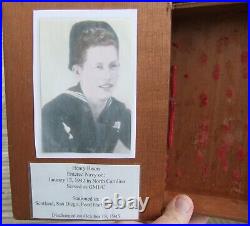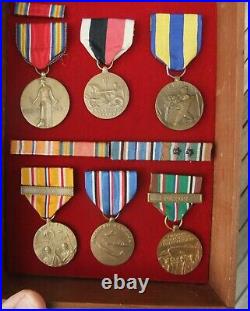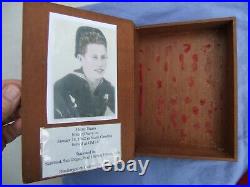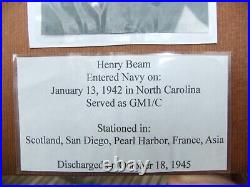Posts tagged occupation
WW1 ITALIAN NAVY DESTROYER R. ” AUDACE ” SERVICE MEDAL (OCCUPATION of TRIESTE). ” AUDACE ” SERVICE MEDAL (OCCUPATION of TRIESTE NOVEMBER 3,1918). III NOVEMBER (NOVEMBER 3). During World War 1 on November 3, 1918, Italian troops entered Trieste, marking the city’s liberation from Austro-Hungarian rule following the victorious Battle of Vittorio Veneto, effectively ending the war on the Italian front in World War I; this day is significant because it signified the annexation of Trieste into the Kingdom of Italy, with the arrival of the first Italian vessel, the destroyer R. , at the port of Trieste. DEORSUM NUMQUAM = (NEVER DOWN). DIMENSIONS : HEIGHT 3/4″ x WIDTH 11/16″ x THICKNESS 1/8. SILVER MEDAL WITH BLUE AND WHITE ENAMEL.
Numbered on rim: No. Full wrap broach pin system. The United States Army of Cuban Occupation Medal was a military award created by the US War Department in June of 1915. The medal recognizes those service members who performed garrison occupation duty in the United States Protectorate over Cuba, following the close of the Spanish-American War.
Lot of 2 world war 2 medals. One is Army of occupation and the other is European African Eastern campaign. Both come in box. Please check out my other items for vintage and old antiques and collectibles with lots of rare items that were found at numerous estates across NYC, NJ, PA, IL and CT! Items are very rare and vintage lots range across many different categories. Most items are from collectors and hobbyist that took care of their belongings.
PLEASE FOLLOW OUR E BAY STORE. SALE SEE OUR STORE. PLEASE READ WHOLE ADD. We do not want your feed back. We want your repeat business. We get that by posting new items at a fair price. The 8th Division was organized at Camp Fremont. From men of the Regular Army, 3 August 1918. 23rd Machine Gun Battalion. 24th Machine Gun Battalion. 8th Field Artillery Brigade. 2nd Field Artillery Regiment. 81st Field Artillery Regiment. 83rd Field Artillery Regiment. 8th Trench Mortar Battery. 22nd Machine Gun Battalion. 320th Field Signal Battalion. Headquarters Troop, 8th Division. 8th Train Headquarters and Military Police. 11th, 31st, 32nd, and 43rd Ambulance Companies and Field Hospitals. In August 1918, Major General Graves, along with his staff, 5000 men, and 100 officers, was transferred to Siberia. In Russia as part of the intervention in the Russian Civil War. Major General Eli A. Helmick succeeded Graves in command of the division. The overseas movement of the division to Europe commenced on October 30, 1918. The 8th Field Artillery Brigade, 8th Infantry Brigade, 16th Infantry Brigade headquarters, and the 319th Engineer Regiment were the only divisional units to go to France. The 13th and 62nd Infantry Regiments were at sea when recalled after the Armistice. The 12th Infantry did not leave its pre-embarkation point at Camp Mills. Because it was quarantined for Spanish influenza. The troops who did reach France became the garrison of Brest. And assisted in building huge camps for troops about to embark for return to the United States. World War I Victory Medal (United States). World War I Victory Medal. Service between April 6, 1917, and November 11, 1918, or with either of the following expeditions. American Expeditionary Forces in European Russia. Between November 12, 1918, and August 5, 1919. American Expeditionary Forces Siberia. Between November 23, 1918, and April 1, 1920. 36 millimeters in diameter. Is a winged Victory. Standing full length and full face. On the reverse is the inscription The Great War for Civilization and the coat of arms for the United States. Surmounted by a fasces. And on either side the names of the Allied and Associated Nations. The medal is suspended by a ring. 1 3/8 inches in length and 36 millimeters in width, composed of two rainbows. And having the red in the middle, with a white thread along each edge. And Secretary of the Navy. The Great War for Civilization. Mexican Border Service Medal. Army of Occupation of Germany Medal. The World War I Victory Medal known prior to establishment of the World War II Victory Medal. In 1945 simply as the Victory Medal was a United States. Designed by James Earle Fraser. Of New York City. Under the direction of the Commission of Fine Arts. Award of a common allied. Service medal was recommended by an inter-allied committee in March 1919. Each allied nation would design a’Victory Medal’ for award to their military personnel, all issues having certain common features, including a winged figure of victory. On the obverse and the same ribbon. The Victory Medal was originally intended to be established by an act of Congress. Authorizing the medal never passed, however, thus leaving the military departments to establish it through general orders. Published orders in April 1919, and the Navy. In June of the same year. The Victory Medal was awarded to military personnel for service between April 6, 1917, and November 11, 1918, or with either of the following expeditions. The front of the bronze medal features a winged Victory. Holding a shield and sword on the front. The back of the bronze medal features “The Great War For Civilization” in all capital letters curved along the top of the medal. Curved along the bottom of the back of the medal are six stars, three on either side of the center column of seven staffs wrapped in a cord. The top of the staff has a round ball on top and is winged on the side. The staff is on top of a shield that says “U” on the left side of the staff and “S” on the right side of the staff. On left side of the staff it lists one World War I Allied. Country per line: France. On the right side of the staff the Allied country names read: Great Britain. (spelled with a U instead of an O as it is spelled now), and China.
Numbered on rim: No. Full wrap broach pin system. The United States Army of Cuban Occupation Medal was a military award created by the US War Department in June of 1915. The medal recognizes those service members who performed garrison occupation duty in the United States Protectorate over Cuba, following the close of the Spanish-American War.
Item: i90865 Authentic Medal of. United States of America American WWII Asiatic-Pacific Campaign Medal 1946 Bronze Medal 70mm x 31mm x 35mm ARMY OF OCCUPATION, Abutments of the Remagen Bridge. 1945, Mount Fuji with low hanging cloud ofver two Japanese Junks boats on wave. Medal Notes: The Army of Occupation Medal is a military award of the United States military which was established by the United States War Department on 5 April 1946. The medal was created in the aftermath of the Second World War to recognize those who had performed occupation service in either Germany, Italy, Austria, Japan or Korea. The original Army of Occupation Medal was intended only for members of the United States Army, but was expanded in 1948 to encompass the United States Air Force shortly after that service’s creation. The Navy and Marine equivalent of the Army of Occupation Medal is the Navy Occupation Service Medal, which features the same ribbon with its own medallion and clasps. Although authorized in 1946, it was not until 1947 that the first Army of Occupation Medals were distributed. The first medal was presented to General of the Army Dwight D. Eisenhower, who had been the Supreme Headquarters Allied Expeditionary Force Commander during World War II. Because of the legal status of West Berlin as an occupied territory, the Army of Occupation Medal was issued for forty-five years until the unification of Germany in 1990, making it one of the longest active military awards of both the Second World War and the Cold War. In addition, some recipients of the award were born two generations after the end of the conflict which the medal was designed to represent. Much like the National Defense Service Medal, the Army of Occupation Medal has come to be considered a “multi-generational” award. Although 30 days in West Berlin was a requirement for issuing the award, it was not unusual for supply sergeants to issue it along with other unit insignia and equipment. If the soldier questioned it, he would be told You aren’t going anywhere for 30 days! Just wait to put it on your uniform. The military history of the United States in World War II covers the war against the Axis Powers, starting with the 7 December 1941 attack on Pearl Harbor. During the first two years of World War II, the United States had maintained formal neutrality as made official in the Quarantine Speech delivered by US President Franklin D. Roosevelt in 1937, while supplying Britain, the Soviet Union, and China with war material through the Lend-Lease Act which was signed into law on 11 March 1941, as well as deploying the US military to replace the British forces stationed in Iceland. Following the “Greer incident” Roosevelt publicly confirmed the “shoot on sight” order on 11 September 1941, effectively declaring naval war on Germany and Italy in the Battle of the Atlantic. In the Pacific Theater, there was unofficial early US combat activity such as the Flying Tigers. During the war some 16,112,566 Americans served in the United States Armed Forces, with 405,399 killed and 671,278 wounded. Key civilian advisors to President Roosevelt included Secretary of War Henry L. Stimson, who mobilized the nation’s industries and induction centers to supply the Army, commanded by General George Marshall and the Army Air Forces under General Hap Arnold. The Navy, led by Secretary of the Navy Frank Knox and Admiral Ernest King, proved more autonomous. Overall priorities were set by Roosevelt and the Joint Chiefs of Staff, chaired by William Leahy. The highest priority was the defeat of Germany in Europe, but first the war against Japan in the Pacific was more urgent after the sinking of the main battleship fleet at Pearl Harbor. Admiral King put Admiral Chester W. The Imperial Japanese Navy had the advantage, taking the Philippines as well as British and Dutch possessions, and threatening Australia but in June 1942, its main carriers were sunk during the Battle of Midway, and the Americans seized the initiative. The Pacific War became one of island hopping, so as to move air bases closer and closer to Japan. The Army, based in Australia under General Douglas MacArthur, steadily advanced across New Guinea to the Philippines, with plans to invade the Japanese home islands in late 1945. With its merchant fleet sunk by American submarines, Japan ran short of aviation gasoline and fuel oil, as the US Navy in June 1944 captured islands within bombing range of the Japanese home islands. Strategic bombing directed by General Curtis Lemay destroyed all the major Japanese cities, as the US captured Okinawa after heavy losses in spring 1945. With the atomic bombings of Hiroshima and Nagasaki, the Soviet invasion of Manchuria, and an invasion of the home islands imminent, Japan surrendered. The war in Europe involved aid to Britain, her allies, and the Soviet Union, with the US supplying munitions until it could ready an invasion force. US forces were first tested to a limited degree in the North African Campaign and then employed more significantly with British Forces in Italy in 194345, where US forces, representing about a third of the Allied forces deployed, bogged down after Italy surrendered and the Germans took over. Finally the main invasion of France took place in June 1944, under General Dwight D. Meanwhile, the US Army Air Forces and the British Royal Air Force engaged in the area bombardment of German cities and systematically targeted German transportation links and synthetic oil plants, as it knocked out what was left of the Luftwaffe post Battle of Britain in 1944. Being invaded from all sides, it became clear that Germany would lose the war. Berlin fell to the Soviets in May 1945, and with Adolf Hitler dead, the Germans surrendered. World-renowned expert numismatist, enthusiast, author and dealer in authentic ancient Greek, ancient Roman, ancient Byzantine, world coins & more. Ilya Zlobin is an independent individual who has a passion for coin collecting, research and understanding the importance of the historical context and significance all coins and objects represent. Send me a message about this and I can update your invoice should you want this method. Getting your order to you, quickly and securely is a top priority and is taken seriously here. Great care is taken in packaging and mailing every item securely and quickly. What is a certificate of authenticity and what guarantees do you give that the item is authentic? You will be very happy with what you get with the COA; a professional presentation of the coin, with all of the relevant information and a picture of the coin you saw in the listing. Additionally, the coin is inside it’s own protective coin flip (holder), with a 2×2 inch description of the coin matching the individual number on the COA. Whether your goal is to collect or give the item as a gift, coins presented like this could be more prized and valued higher than items that were not given such care and attention to. When should I leave feedback? Please don’t leave any negative feedbacks, as it happens sometimes that people rush to leave feedback before letting sufficient time for their order to arrive. The matter of fact is that any issues can be resolved, as reputation is most important to me. My goal is to provide superior products and quality of service. How and where do I learn more about collecting ancient coins? Visit the Guide on How to Use My Store. For on an overview about using my store, with additional information and links to all other parts of my store which may include educational information on topics you are looking for.
Item: i93155 Authentic Medal of. United States of America American WWII Asiatic-Pacific Campaign Medal 1946 Bronze Medal 67mm x 31mm ARMY OF OCCUPATION GERMANY, Abutments of the Remagen Bridge. 1945, Mount Fuji with low hanging cloud over two Japanese Junks boats on wave. Medal Notes: The Army of Occupation Medal is a military award of the United States military which was established by the United States War Department on 5 April 1946. The medal was created in the aftermath of the Second World War to recognize those who had performed occupation service in either Germany, Italy, Austria, Japan or Korea. The original Army of Occupation Medal was intended only for members of the United States Army, but was expanded in 1948 to encompass the United States Air Force shortly after that service’s creation. The Navy and Marine equivalent of the Army of Occupation Medal is the Navy Occupation Service Medal, which features the same ribbon with its own medallion and clasps. Although authorized in 1946, it was not until 1947 that the first Army of Occupation Medals were distributed. The first medal was presented to General of the Army Dwight D. Eisenhower, who had been the Supreme Headquarters Allied Expeditionary Force Commander during World War II. Because of the legal status of West Berlin as an occupied territory, the Army of Occupation Medal was issued for forty-five years until the unification of Germany in 1990, making it one of the longest active military awards of both the Second World War and the Cold War. In addition, some recipients of the award were born two generations after the end of the conflict which the medal was designed to represent. Much like the National Defense Service Medal, the Army of Occupation Medal has come to be considered a “multi-generational” award. Although 30 days in West Berlin was a requirement for issuing the award, it was not unusual for supply sergeants to issue it along with other unit insignia and equipment. If the soldier questioned it, he would be told You aren’t going anywhere for 30 days! Just wait to put it on your uniform. The military history of the United States in World War II covers the war against the Axis Powers, starting with the 7 December 1941 attack on Pearl Harbor. During the first two years of World War II, the United States had maintained formal neutrality as made official in the Quarantine Speech delivered by US President Franklin D. Roosevelt in 1937, while supplying Britain, the Soviet Union, and China with war material through the Lend-Lease Act which was signed into law on 11 March 1941, as well as deploying the US military to replace the British forces stationed in Iceland. Following the “Greer incident” Roosevelt publicly confirmed the “shoot on sight” order on 11 September 1941, effectively declaring naval war on Germany and Italy in the Battle of the Atlantic. In the Pacific Theater, there was unofficial early US combat activity such as the Flying Tigers. During the war some 16,112,566 Americans served in the United States Armed Forces, with 405,399 killed and 671,278 wounded. Key civilian advisors to President Roosevelt included Secretary of War Henry L. Stimson, who mobilized the nation’s industries and induction centers to supply the Army, commanded by General George Marshall and the Army Air Forces under General Hap Arnold. The Navy, led by Secretary of the Navy Frank Knox and Admiral Ernest King, proved more autonomous. Overall priorities were set by Roosevelt and the Joint Chiefs of Staff, chaired by William Leahy. The highest priority was the defeat of Germany in Europe, but first the war against Japan in the Pacific was more urgent after the sinking of the main battleship fleet at Pearl Harbor. Admiral King put Admiral Chester W. The Imperial Japanese Navy had the advantage, taking the Philippines as well as British and Dutch possessions, and threatening Australia but in June 1942, its main carriers were sunk during the Battle of Midway, and the Americans seized the initiative. The Pacific War became one of island hopping, so as to move air bases closer and closer to Japan. The Army, based in Australia under General Douglas MacArthur, steadily advanced across New Guinea to the Philippines, with plans to invade the Japanese home islands in late 1945. With its merchant fleet sunk by American submarines, Japan ran short of aviation gasoline and fuel oil, as the US Navy in June 1944 captured islands within bombing range of the Japanese home islands. Strategic bombing directed by General Curtis Lemay destroyed all the major Japanese cities, as the US captured Okinawa after heavy losses in spring 1945. With the atomic bombings of Hiroshima and Nagasaki, the Soviet invasion of Manchuria, and an invasion of the home islands imminent, Japan surrendered. The war in Europe involved aid to Britain, her allies, and the Soviet Union, with the US supplying munitions until it could ready an invasion force. US forces were first tested to a limited degree in the North African Campaign and then employed more significantly with British Forces in Italy in 194345, where US forces, representing about a third of the Allied forces deployed, bogged down after Italy surrendered and the Germans took over. Finally the main invasion of France took place in June 1944, under General Dwight D. Meanwhile, the US Army Air Forces and the British Royal Air Force engaged in the area bombardment of German cities and systematically targeted German transportation links and synthetic oil plants, as it knocked out what was left of the Luftwaffe post Battle of Britain in 1944. Being invaded from all sides, it became clear that Germany would lose the war. Berlin fell to the Soviets in May 1945, and with Adolf Hitler dead, the Germans surrendered. World-renowned expert numismatist, enthusiast, author and dealer in authentic ancient Greek, ancient Roman, ancient Byzantine, world coins & more. Ilya Zlobin is an independent individual who has a passion for coin collecting, research and understanding the importance of the historical context and significance all coins and objects represent. Send me a message about this and I can update your invoice should you want this method. Getting your order to you, quickly and securely is a top priority and is taken seriously here. Great care is taken in packaging and mailing every item securely and quickly. What is a certificate of authenticity and what guarantees do you give that the item is authentic? You will be very happy with what you get with the COA; a professional presentation of the coin, with all of the relevant information and a picture of the coin you saw in the listing. Additionally, the coin is inside it’s own protective coin flip (holder), with a 2×2 inch description of the coin matching the individual number on the COA. Whether your goal is to collect or give the item as a gift, coins presented like this could be more prized and valued higher than items that were not given such care and attention to. When should I leave feedback? Please don’t leave any negative feedbacks, as it happens sometimes that people rush to leave feedback before letting sufficient time for their order to arrive. The matter of fact is that any issues can be resolved, as reputation is most important to me. My goal is to provide superior products and quality of service. How and where do I learn more about collecting ancient coins? Visit the Guide on How to Use My Store. For on an overview about using my store, with additional information and links to all other parts of my store which may include educational information on topics you are looking for. This item is in the category “Collectibles\Militaria\WW II (1939-45)\Original Period Items\United States\Medals & Ribbons”. The seller is “highrating_lowprice” and is located in this country: US. This item can be shipped worldwide.
- Country/Region of Manufacture: United States
